Acute Effects of Diaphragmatic Breathing on Trunk and Shoulder Mobility and Pulmonary Function in Healthy Young Adults
Abstract
1. Introduction
2. Materials and Methods
2.1. Design and Procedures
2.2. Subjects
2.3. Experimental Protocol
2.4. Mobility Tests
2.4.1. Chest Expansion Test
2.4.2. Thoracic Spine Rotation Test
2.4.3. Lateral Trunk Flexion Test
2.4.4. Shoulder Girdle Mobility Test
2.4.5. Pulmonary Function Test
2.5. Statistical Analysis
3. Results
4. Discussion
5. Conclusions
Author Contributions
Funding
Institutional Review Board Statement
Informed Consent Statement
Data Availability Statement
Conflicts of Interest
Abbreviations
| CE | chest expansion |
| ES | effect size |
| FEV1 | force expiratory volume in first second |
| FVC | force vital capacity |
| LTF | lateral trunk flexion |
| SGM | shoulder girdle mobility |
| TSR | thoracic spine rotation |
References
- Wilmore, J.H.; Costill, D.L.; Kenney, W.L. Physiology of Sport and Exercise; Human Kinetics: Champaign, IL, USA, 2004; Volume 20. [Google Scholar]
- da Silva, M.R.; Peruzzolo, C.C.; Canizelli, J.; Montemezzo, D.; Paulin, E. Acute effects of breathing exercises on diaphragmatic mobility and respiratory muscles activity in healthy adults. Cardiorespir. Physiother. Crit. Care Rehabil. 2022, 1, e42701. [Google Scholar] [CrossRef]
- Zou, Y.; Zhao, X.; Hou, Y.-Y.; Liu, T.; Wu, Q.; Huang, Y.-H.; Wang, X.-H. Meta-analysis of effects of voluntary slow breathing exercises for control of heart rate and blood pressure in patients with cardiovascular diseases. Am. J. Cardiol. 2017, 120, 148–153. [Google Scholar] [CrossRef] [PubMed]
- Jerath, R.; Edry, J.W.; Barnes, V.A.; Jerath, V. Physiology of long pranayamic breathing: Neural respiratory elements may provide a mechanism that explains how slow deep breathing shifts the autonomic nervous system. Med. Hypotheses 2006, 67, 566–571. [Google Scholar] [CrossRef] [PubMed]
- Kowalski, T.; Obmiński, Z.; Waleriańczyk, W.; Klusiewicz, A. The acute effect of respiratory muscle training on cortisol, testosterone, and testosterone-to-cortisol ratio in well-trained triathletes-exploratory study. Respir. Physiol. Neurobiol. 2025, 331, 104353. [Google Scholar] [CrossRef] [PubMed]
- Hopper, S.I.; Murray, S.L.; Ferrara, L.R.; Singleton, J.K. Effectiveness of diaphragmatic breathing for reducing physiological and psychological stress in adults: A quantitative systematic review. JBI Evid. Synth. 2019, 17, 1855–1876. [Google Scholar] [CrossRef]
- Anderson, B.E.; Bliven, K.C.H. The use of breathing exercises in the treatment of chronic, nonspecific low back pain. J. Sport Rehabil. 2017, 26, 452–458. [Google Scholar] [CrossRef]
- Wang, H.; Cochrane, T. Mobility impairment, muscle imbalance, muscle weakness, scapular asymmetry and shoulder injury in elite volleyball athletes. J. Sports Med. Phys. Fit. 2001, 41, 403–410. [Google Scholar]
- Kang, S.W.; Lee, W.N.; Moon, J.H.; Chun, S.I. Correlation of spinal mobility with the severity of chronic lower back pain. Yonsei Med. J. 1995, 36, 37–44. [Google Scholar] [CrossRef]
- Yong, M.-S.; Lee, H.-Y.; Lee, Y.-S. Effects of diaphragm breathing exercise and feedback breathing exercise on pulmonary function in healthy adults. J. Phys. Ther. Sci. 2017, 29, 85–87. [Google Scholar] [CrossRef]
- Franklin, E. Breathing for Peak Performance: Functional Exercises for Dance, Yoga, and Pilates; Human Kinetics: Champaign, IL, USA, 2018. [Google Scholar]
- Liu, X.; Yang, Y.; Jia, J. Respiratory muscle ultrasonography evaluation and its clinical application in stroke patients: A review. Front. Neurosci. 2023, 17, 1132335. [Google Scholar] [CrossRef]
- Sinderby, C.; Beck, J.; Spahija, J.; Weinberg, J.; Grassino, A. Voluntary activation of the human diaphragm in health and disease. J. Appl. Physiol. 1998, 85, 2146–2158. [Google Scholar] [CrossRef] [PubMed]
- Peper, E.; Booiman, A.; Lin, I.-M.; Harvey, R.; Mitose, J. Abdominal SEMG feedback for diaphragmatic breathing: A methodological note. Biofeedback 2016, 44, 42–49. [Google Scholar] [CrossRef]
- Aliverti, A. Monitoring of Respiratory Mechanics in the Intensive Care Unit: Models, Techniques and Measurement Methods. In Respiratory System and Artificial Ventilation; Springer: Berlin/Heidelberg, Germany, 2008; pp. 73–97. [Google Scholar]
- Gilbert, C.; Chaitow, L.; Bradley, D. Recognizing and Treating Breathing Disorders: A Multidisciplinary Approach; Elsevier Health Sciences: Amsterdam, The Netherlands, 2014. [Google Scholar]
- Csepregi, É.; Gyurcsik, Z.; Veres-Balajti, I.; Nagy, A.C.; Szekanecz, Z.; Szántó, S. Effects of classical breathing exercises on posture, spinal and chest mobility among female university students compared to currently popular training programs. Int. J. Environ. Res. Public Health 2022, 19, 3728. [Google Scholar] [CrossRef]
- Mohammad-Rahimi, N.; Mahdavinezhad, R.; Attarzadeh-Hosseini, S.; Negahban, H. Effect of dynamic neuromuscular stabilization breathing exercises on respiratory function of sedentary students with poor posture. Health Educ. Health Promot. 2020, 8, 19–24. [Google Scholar]
- Atalay, E.S.; Soylu, Ç.; Atalay, G.; Yıldırım, N.Ü. Effect of Diaphragmatic Breathing on Shoulder Rotational Mobility-Single-Blind Randomized Controlled Study. Istanb. Gelisim Univ. J. Health Sci. 2023, 21, 819–827. [Google Scholar] [CrossRef]
- Kim, K.; Park, R.-J.; Bae, S.-S. Effect of diaphragmatic breathing exercise on activation of trunk muscle of patients with low back pain. J. Korean Phys. Ther. 2005, 17, 311–327. [Google Scholar]
- Nambi, G.; Abdelbasset, W.K.; Elshehawy, A.A.; Eltrawy, H.H.; Abodonya, A.M.; Saleh, A.K.; Hussein, R.S. Yoga in Burn: Role of pranayama breathing exercise on pulmonary function, respiratory muscle activity and exercise tolerance in full-thickness circumferential burns of the chest. Burns 2021, 47, 206–214. [Google Scholar] [CrossRef]
- Fregonezi, G.d.F.; Resqueti, V.; Rous, R.G. Pursed lips breathing. Arch. De Bronconeumol. 2004, 40, 279–282. [Google Scholar] [CrossRef]
- Chaudhary, D.; Khanna, S.; Maurya, U.K.; Shenoy, S. Effects of Buteyko breathing technique on physiological and psychological parameters among University football players. Eur. J. Mol. Clin. Med. 2021, 8, 1790–1800. [Google Scholar]
- Hosseinifar, M.; Akbari, A.; Ghiasi, F.; Shamsoaldini, N.; Shahraki, R. The effects of proprioceptive neuromuscular facilitation exercises on pain, function, lumbar mobility, and lumbar lordosis in patients with non-specific chronic low back pain. J. Pharm. Res. Allied Sci. 2016, 5, 250–261. [Google Scholar]
- Strunce, J.B.; Walker, M.J.; Boyles, R.E.; Young, B.A. The immediate effects of thoracic spine and rib manipulation on subjects with primary complaints of shoulder pain. J. Man. Manip. Ther. 2009, 17, 230–236. [Google Scholar] [CrossRef]
- Mohammad Rahimi, N.; Mahdavinezhad, R.; Attarzadeh Hosseini, S.R.; Negahban, H. Effect of dynamic neuromuscular stabilization breathing exercises on some spirometry indices of sedentary students with poor posture. Phys. Treat.-Specif. Phys. Ther. J. 2019, 9, 169–176. [Google Scholar] [CrossRef]
- Seo, K.; Cho, M. The effects of a balloon-blowing exercise in a 90/90 bridge position using a ball on the pulmonary function of females in their twenties. J. Phys. Ther. Sci. 2018, 30, 1267–1270. [Google Scholar] [CrossRef]
- Kim, M.-J.; Park, D.-S. The effect of Schroth’s three-dimensional exercises in combination with respiratory muscle exercise on Cobb’s angle and pulmonary function in patients with idiopathic scoliosis. Phys. Ther. Rehabil. Sci. 2017, 6, 113–119. [Google Scholar] [CrossRef]
- Hamasaki, H. Effects of diaphragmatic breathing on health: A narrative review. Medicines 2020, 7, 65. [Google Scholar] [CrossRef]
- Laborde, S.; Zammit, N.; Iskra, M.; Mosley, E.; Borges, U.; Allen, M.S.; Javelle, F. The influence of breathing techniques on physical sport performance: A systematic review and meta-analysis. Int. Rev. Sport Exerc. Psychol. 2024, 17, 1222–1277. [Google Scholar] [CrossRef]
- Da Cruz, L.B.V.; de Freitas Pupin, C.; Verri, E.D. The influence of respiratory techniques on sports performance: Literature review. Res. Soc. Dev. 2024, 13, e0813946759. [Google Scholar] [CrossRef]
- Garg, P.; Mendiratta, A.; Banga, A.; Bucharles, A.; Piccoli, M.V.F.; Kamaraj, B.; Qasba, R.K.; Bansal, V.; Thimmapuram, J.; Pargament, R. Effect of breathing exercises on blood pressure and heart rate: A systematic review and meta-analysis. Int. J. Cardiol. Cardiovasc. Risk Prev. 2024, 20, 200232. [Google Scholar] [CrossRef]
- Ubolnuar, N.; Tantisuwat, A.; Thaveeratitham, P.; Lertmaharit, S.; Kruapanich, C.; Mathiyakom, W. Effects of breathing exercises in patients with chronic obstructive pulmonary disease: Systematic review and meta-analysis. Ann. Rehabil. Med. 2019, 43, 509–523. [Google Scholar] [CrossRef]
- Munawwarah, M.; Ivanali, K.; Amir, T.L. The effect of additional breathing exercises in postural training on decreasing the hyperkyphosis curve in the elderly. Phys. Ther. J. Indones. 2023, 4, 36–40. [Google Scholar] [CrossRef]
- Yu, L.; Gu, Q.; Kim, T. The effects of cervical stabilization exercises with breathing exercises on respiratory function in subjects with forward head posture. WSEAS Trans. Syst. Control 2021, 16, 486–492. [Google Scholar] [CrossRef]
- LoMauro, A.; Aliverti, A. Sex differences in respiratory function. Breathe 2018, 14, 131–140. [Google Scholar] [CrossRef]
- Molgat-Seon, Y.; Peters, C.M.; Sheel, A.W. Sex-differences in the human respiratory system and their impact on resting pulmonary function and the integrative response to exercise. Curr. Opin. Physiol. 2018, 6, 21–27. [Google Scholar] [CrossRef]
- Pan, F. The Effect of Age and Sex on Spinal Shape and Mobility in Asymptomatic Adults: Systematic Reviews and Meta-Analyses. Ph.D. Thesis, Freie University Berlin, Berlin, Germany, 2019. [Google Scholar]
- Boyle, K.L.; Olinick, J.; Lewis, C. The value of blowing up a balloon. N. Am. J. Sports Phys. Ther. 2010, 5, 179. [Google Scholar]
- Debouche, S.; Pitance, L.; Robert, A.; Liistro, G.; Reychler, G. Reliability and reproducibility of chest wall expansion measurement in young healthy adults. J. Manip. Physiol. Ther. 2016, 39, 443–449. [Google Scholar] [CrossRef]
- Mohan, V.; Dzulkifli, N.H.; Justine, M.; Haron, R.; Rathinam, C. Intrarater reliability of chest expansion using cloth tape measure technique. Bangladesh J. Med. Sci. 2012, 11, 307–311. [Google Scholar] [CrossRef]
- Johnson, K.D.; Kim, K.-M.; Yu, B.-K.; Saliba, S.A.; Grindstaff, T.L. Reliability of thoracic spine rotation range-of-motion measurements in healthy adults. J. Athl. Train. 2012, 47, 52–60. [Google Scholar] [CrossRef]
- Puig-Diví, A.; Escalona-Marfil, C.; Padullés-Riu, J.M.; Busquets, A.; Padullés-Chando, X.; Marcos-Ruiz, D. Validity and reliability of the Kinovea program in obtaining angles and distances using coordinates in 4 perspectives. PLoS ONE 2019, 14, e0216448. [Google Scholar] [CrossRef]
- Cohen, J. Statistical Power Analysis for the Behavioral Sciences; Routledge: Oxfordshire, UK, 2013. [Google Scholar]
- Kocjan, J.; Adamek, M.; Gzik-Zroska, B.; Czyżewski, D.; Rydel, M. Network of breathing. Multifunctional role of the diaphragm: A review. Adv. Respir. Med. 2017, 85, 224–232. [Google Scholar] [CrossRef]
- Liebsch, C.; Wilke, H.-J. Basic biomechanics of the thoracic spine and rib cage. In Biomechanics of the Spine; Elsevier: Amsterdam, The Netherlands, 2018; pp. 35–50. [Google Scholar]
- Culham, E.G.; Jimenez, H.A.; King, C.E. Thoracic kyphosis, rib mobility, and lung volumes in normal women and women with osteoporosis. Spine 1994, 19, 1250–1255. [Google Scholar] [CrossRef]
- Heneghan, N.R.; Webb, K.; Mahoney, T.; Rushton, A. Thoracic spine mobility, an essential link in upper limb kinetic chains in athletes: A systematic review. Transl. Sports Med. 2019, 2, 301–315. [Google Scholar] [CrossRef]
- Nelson, N. Diaphragmatic breathing: The foundation of core stability. Strength Cond. J. 2012, 34, 34–40. [Google Scholar] [CrossRef]
- Busch, V.; Magerl, W.; Kern, U.; Haas, J.; Hajak, G.; Eichhammer, P. The effect of deep and slow breathing on pain perception, autonomic activity, and mood processing—An experimental study. Pain Med. 2012, 13, 215–228. [Google Scholar] [CrossRef]
- Lehrer, P.M.; Gevirtz, R. Heart rate variability biofeedback: How and why does it work? Front. Psychol. 2014, 5, 756. [Google Scholar] [CrossRef]
- De Bernardi, F.; Fogliata, A.; Garassino, A. Multifunctional role of the diaphragm: Biomechanical analysis and new perspectives. MOJ Sports Med. 2024, 7, 9–13. [Google Scholar] [CrossRef]
- Fogarty, M.J.; Mantilla, C.B.; Sieck, G.C. Breathing: Motor control of diaphragm muscle. Physiology 2018, 33, 113–126. [Google Scholar] [CrossRef]
- Sedaghati, P.; Derakhshan, K.F.; Ahmadabadi, S.; Moghaddam, S.R.R. Effects of corrective and breathing exercises on respiratory function of older adults with a history of COVID-19 infection: A randomized controlled trial. BMC Complement. Med. Ther. 2023, 23, 199. [Google Scholar] [CrossRef]
- Sivakumar, G.; Prabhu, K.; Baliga, R.; Pai, M.K.; Manjunatha, S. Acute effects of deep breathing for a short duration (2–10 minutes) on pulmonary functions in healthy young volunteers. Indian J. Physiol. Pharmacol. 2011, 55, 154–159. [Google Scholar]
- David, S.; Goldin, J.; Edwards, C.W. Forced expiratory volume. In StatPearls [Internet]; StatPearls Publishing: Treasure Island, FL, USA, 2024. [Google Scholar]
- Obayashi, H.; Urabe, Y.; Yamanaka, Y.; Okuma, R. Effects of respiratory-muscle exercise on spinal curvature. J. Sport Rehabil. 2012, 21, 63–68. [Google Scholar] [CrossRef]
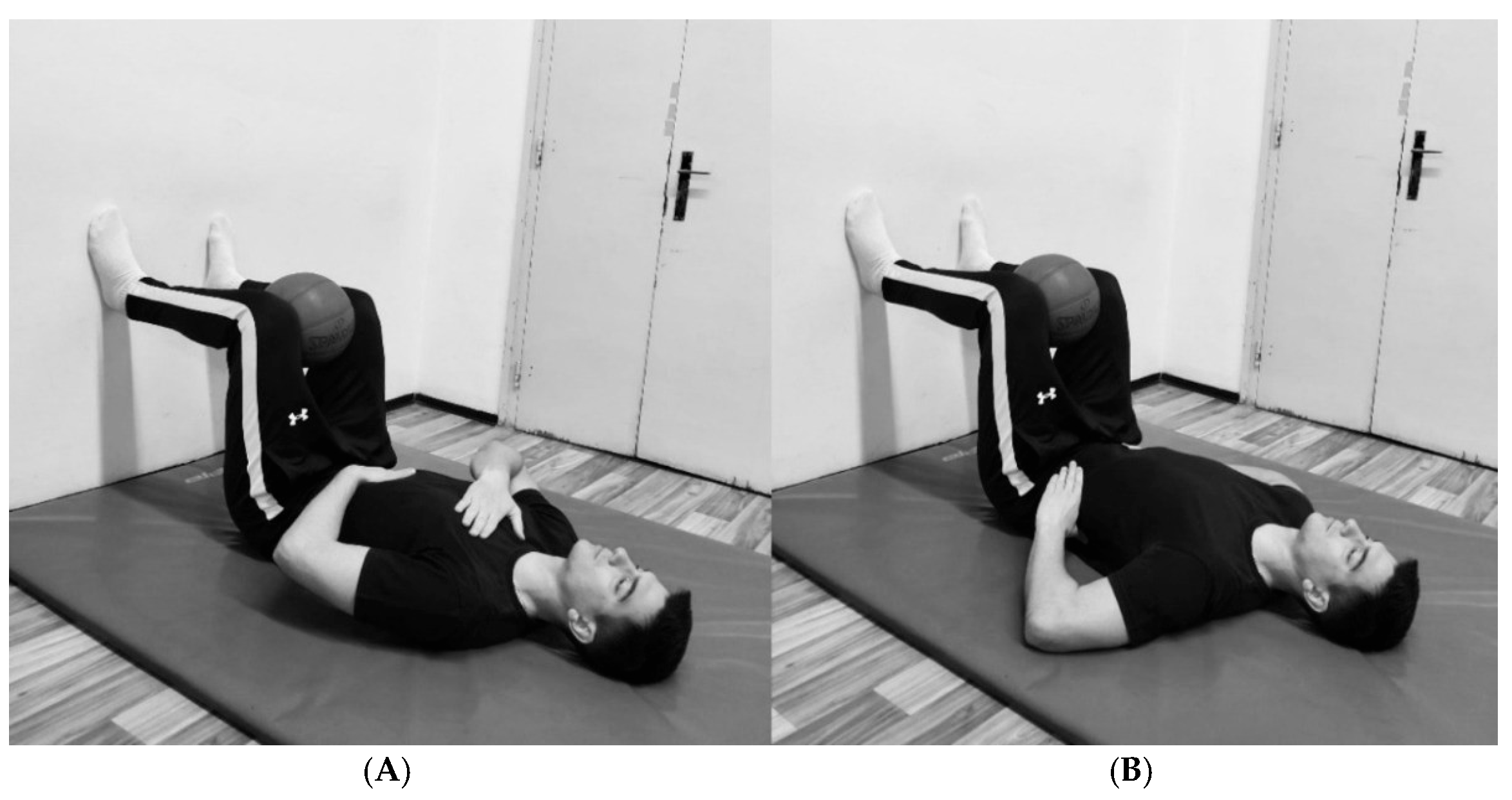
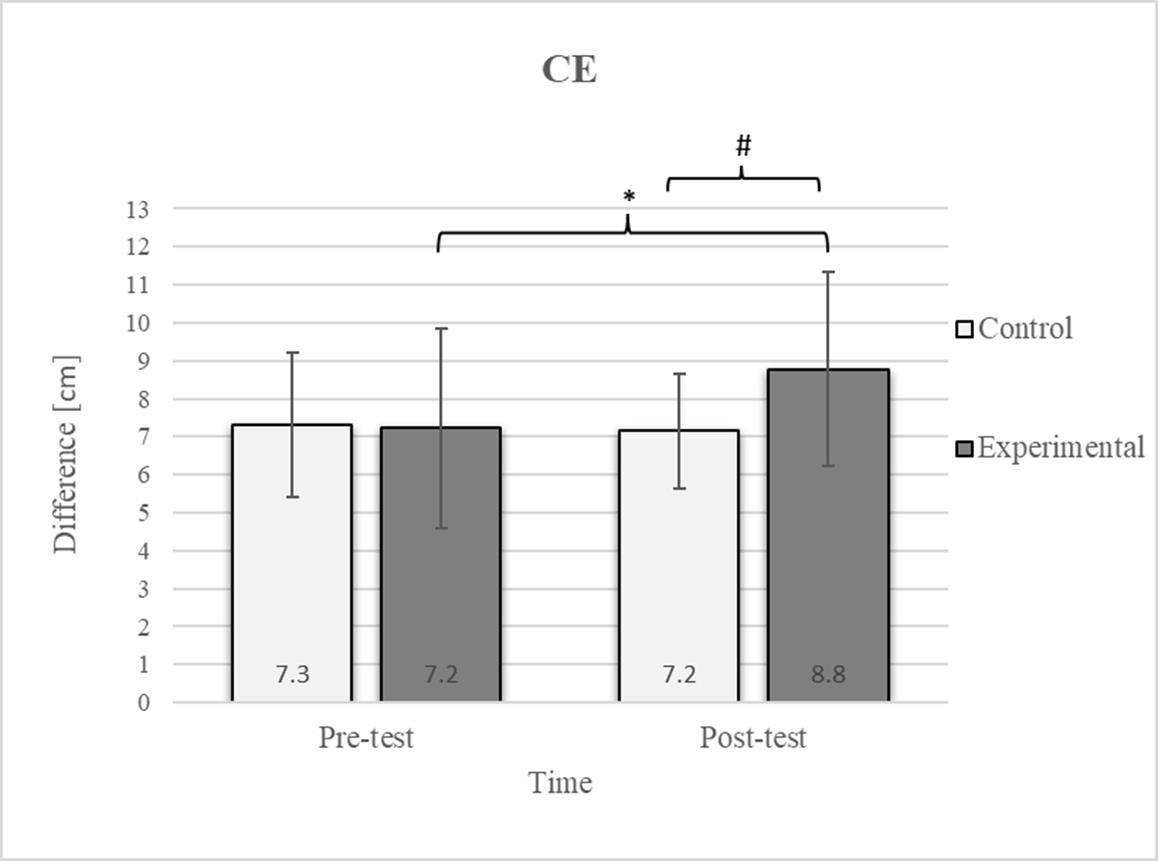
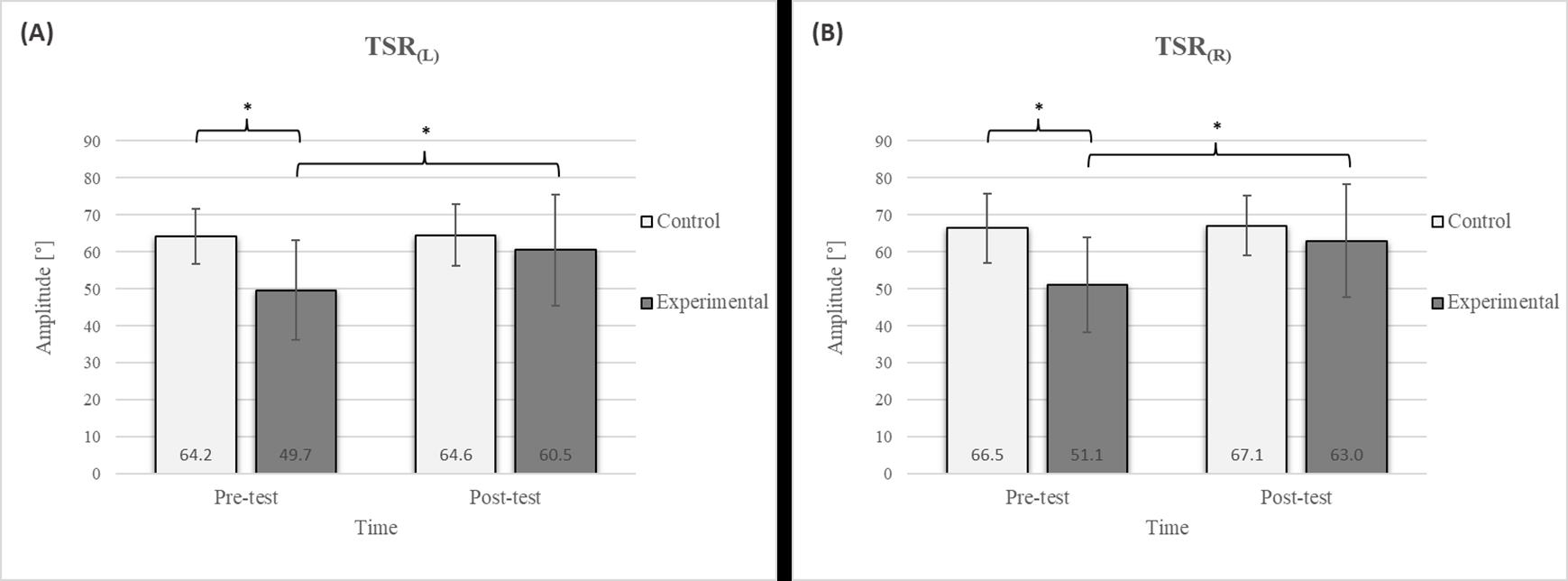


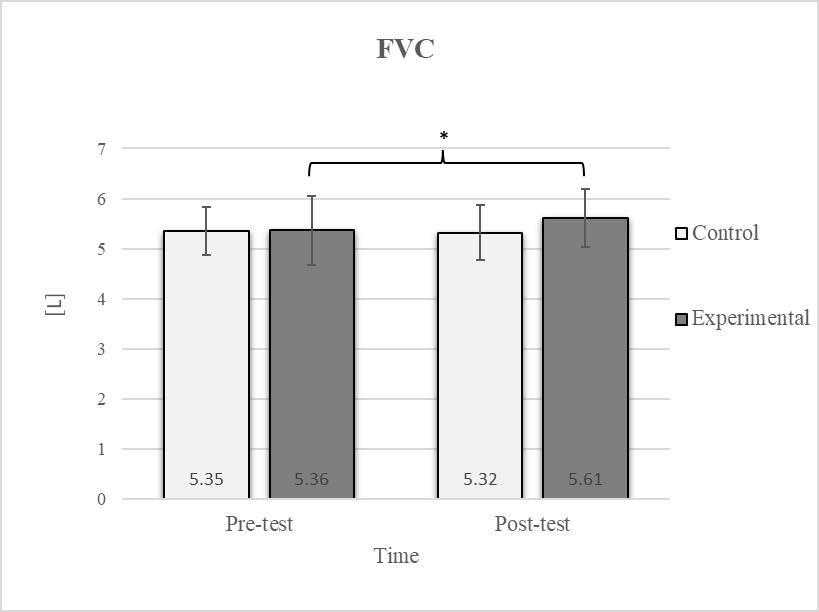

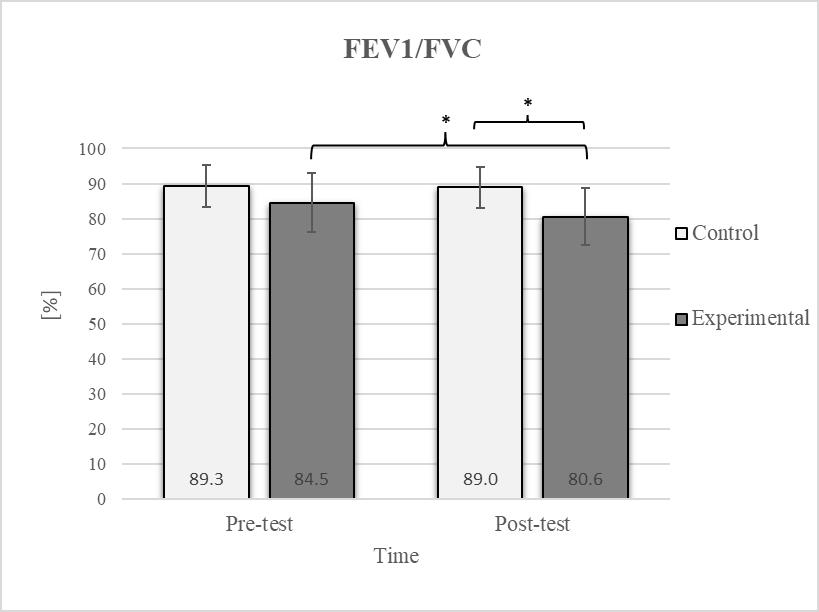
| Group | Time | Group × Time | |
|---|---|---|---|
| CE | F(1) = 0.81 p = 0.38 pη2 = 0.03 | F(1) = 17.17 p ≤ 0.01 * pη2 = 0.42 | F(1) = 25.64 p ≤ 0.01 * pη2 = 0.52 |
| TSR(L) | F(1) = 4.22 p = 0.05 * pη2 = 0.15 | F(1)= 79.72 p ≤ 0.01 * pη2 = 0.77 | F(1) = 70.35 p ≤ 0.01 * pη2 = 0.75 |
| TSR(R) | F(1) = 4.56 p ≤ 0.05 * pη2 = 0.16 | F(1) = 51.22 p ≤ 0.01 * pη2 = 0.68 | F(1) = 40.71 p ≤ 0.01 * pη2 = 0.63 |
| LTF(L) | F(1) = 0.00 p = 0.99 pη2 = 0.00 | F(1) = 7.31 p = 0.01 * pη2 = 0.23 | F(1) = 16.16 p ≤ 0.01 * pη2 = 0.40 |
| LTF(R) | F(1) = 0.04 p = 0.85 pη2 = 0.00 | F(1) = 21.74 p ≤ 0.01 * pη2 = 0.48 | F(1) = 25.13 p ≤ 0.01 * pη2 = 0.51 |
| SGM(L) | F(1) = 0.73 p = 0.40 pη2 = 0.03 | F(1) = 29.71 p ≤ 0.01 * pη2 = 0.55 | F(1) = 29.11 p ≤ 0.01 * pη2 = 0.55 |
| SGM(R) | F(1) = 1.31 p = 0.26 pη2 = 0.05 | F(1) = 12.26 p ≤ 0.01 * pη2 = 0.34 | F(1) = 18.77 p ≤ 0.01 * pη2 = 0.44 |
| FVC | F(1) = 0.46 p = 0.50 pη2 = 0.02 | F(1) = 6.41 p ≤ 0.05 * pη2 = 0.21 | F(1) = 9.52 p ≤ 0.01 * pη2 = 0.28 |
| FEV1 | F(1) = 1.65 p = 0.21 pη2 = 0.06 | F(1) = 1.53 p = 0.23 pη2 = 0.06 | F(1) = 0.72 p = 0.41 pη2 = 0.03 |
| FEV1/FVC | F(1) = 5.96 p ≤ 0.05 * pη2 = 0.20 | F(1) = 5.45 p ≤ 0.05 * pη2 = 0.18 | F(1) = 3.87 p = 0.06 # pη2 = 0.14 |
Disclaimer/Publisher’s Note: The statements, opinions and data contained in all publications are solely those of the individual author(s) and contributor(s) and not of MDPI and/or the editor(s). MDPI and/or the editor(s) disclaim responsibility for any injury to people or property resulting from any ideas, methods, instructions or products referred to in the content. |
© 2025 by the authors. Licensee MDPI, Basel, Switzerland. This article is an open access article distributed under the terms and conditions of the Creative Commons Attribution (CC BY) license (https://creativecommons.org/licenses/by/4.0/).
Share and Cite
Ristovski, A.; Kapeleti, M.; Zlatović, I.; Mrdaković, V. Acute Effects of Diaphragmatic Breathing on Trunk and Shoulder Mobility and Pulmonary Function in Healthy Young Adults. J. Funct. Morphol. Kinesiol. 2025, 10, 325. https://doi.org/10.3390/jfmk10030325
Ristovski A, Kapeleti M, Zlatović I, Mrdaković V. Acute Effects of Diaphragmatic Breathing on Trunk and Shoulder Mobility and Pulmonary Function in Healthy Young Adults. Journal of Functional Morphology and Kinesiology. 2025; 10(3):325. https://doi.org/10.3390/jfmk10030325
Chicago/Turabian StyleRistovski, Ana, Marko Kapeleti, Igor Zlatović, and Vladimir Mrdaković. 2025. "Acute Effects of Diaphragmatic Breathing on Trunk and Shoulder Mobility and Pulmonary Function in Healthy Young Adults" Journal of Functional Morphology and Kinesiology 10, no. 3: 325. https://doi.org/10.3390/jfmk10030325
APA StyleRistovski, A., Kapeleti, M., Zlatović, I., & Mrdaković, V. (2025). Acute Effects of Diaphragmatic Breathing on Trunk and Shoulder Mobility and Pulmonary Function in Healthy Young Adults. Journal of Functional Morphology and Kinesiology, 10(3), 325. https://doi.org/10.3390/jfmk10030325






